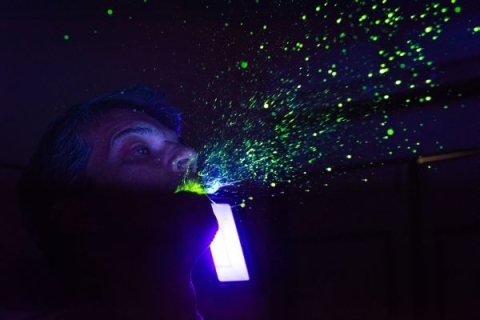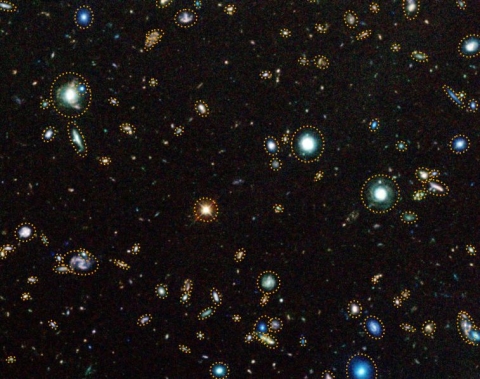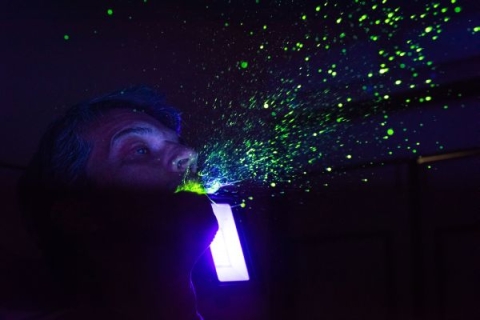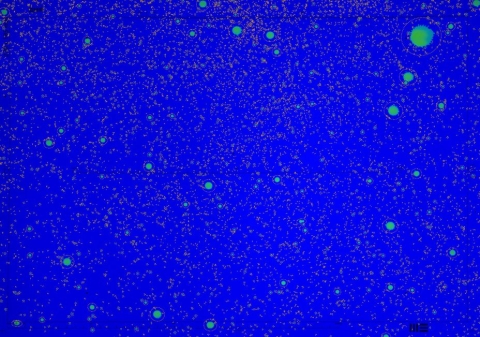

Our cosmologists aren’t just studying galaxies and black holes but also droplets that potentially carry viruses. Christopher Pattison, Senior Research Associate, explains how. 30 September 2022 7 min read
Imagine a picture of the night sky taken by a telescope. It contains hundreds of bright objects and we want to know exactly how many it contains and how big they each are. Counting them and working all this out by hand would take far too long, so we need to get a computer to do it for us.
There are plenty of algorithms we can use to find all of the bright objects in the image (we use one called Source Extractor), and they can tell us the number of pixels that make up the object, what shape is it and even how bright each object appears.
In the first image below, I’ve taken a small section of the famous Hubble Deep Field image that shows many faint galaxies deep in space. There are lots of bright stars and galaxies here, so let’s ask our code to find the brightest 40 objects and draw a nice circle around them so they are easy for us to find.

Tricking the code
Interestingly, we can trick the code into finding other things for us in other images too. The code doesn’t care if it’s looking for stars and galaxies or any other bright things in the image. With this in mind, let’s think about coughs and the spread of diseases.
Imagine that we have a person coughing in a room. Where do all the droplets go from the cough if this person doesn’t cover their mouth? Droplets of spit are generally hard to image; they are mostly water, transparent, and moving fast. It’s like trying to take a good video of the rain - even if it’s coming down really hard, it normally doesn’t look very impressive on a video on your phone.

Here at the University of Portsmouth, along with colleagues at the Portsmouth Hospitals Trust, University of Bristol, Brunel University and more, we’ve developed a way to see these droplets easily and study how they spread out and land.
This is where our astronomy codes from before come in. We can run each of our images through our galaxy finding software, but now it's finding us bright spots of spit from our cough. This tells us how many droplets each cough produces, how big and what shape they are, and how far each of them travels. This is a powerful technique that lets us track droplets of sizes that are traditionally very difficult to follow.
Christopher Pattison, Senior Research Associate
We start by mixing a fluorescent dye (we use fluorescein, commonly used in ophthalmology and very safe for humans) with some saline. We use this as a mouthwash for our volunteer cougher, staining the inside of their mouth and their saliva.
Note that for some experiments we used a “cough model” instead of a human volunteer. This produces a very reliable and reproducible cough (in terms of speed, direction, etc) and with fewer risks than a human volunteer (i.e. spreading covid during the pandemic), allowing us to do quicker experiments with reliable results.
Next, we produce a cough in an environment we are interested in, for example different areas of a hospital or operating theatres with different types of ventilation. This produces a spray of fluorescent saliva that is much easier to track than normal saliva. We also lay out targets in front of the cough so we can easily compare the same distances from the cough over multiple tests.
The next step is to photograph the areas around the cougher to document where all of the saliva has ended up. This photography is done under a blue light, so the room looks dark but the dye is glowing a bright yellow colour. This allows us to map the area where the cough has landed, and leaves us images that look surprisingly similar to a starry night sky.

This is where Space comes in
This is where our astronomy codes from before come in. We can run each of our images through our galaxy finding software, but now it's finding us bright spots of spit from our cough. This tells us how many droplets each cough produces, how big and what shape they are, and how far each of them travels. This is a powerful technique that lets us track droplets of sizes that are traditionally very difficult to follow.
We are using this technique in many different environments. For example, we’ve studied hospital operating theatres with both standard ventilation and more powerful laminar flow ventilation. We saw that while the laminar flow ventilation was very effective at removing small droplets from the air, larger droplets were still able to travel several metres through the powerful ventilation.
We also performed a dental drilling procedure on a phantom head with fluorescent saliva. We saw droplets travel further than one metre, and recorded them in surprising locations far from the drill. For example on the lights above the chair, the light switches for the room, and even the face of the dentist behind their face shield.
Similarly, we performed coughs in both indoor and outdoors environments. We again saw that the outdoor breeze was effective at blowing small droplets away, larger droplets tend to persist for long distances (we observed up to four metres). This can be significant because larger droplets have the potential to carry a significantly larger viral load.
What the future holds
In the immediate future, this can be used to improve cleaning practices in public spaces. Droplets from coughs often spread further than the usually quoted two metre safe zone, which primarily originates from studies done over 70 years ago.
This research combines the seemingly unrelated fields of astronomy and epidemiology in an interesting and surprising way, and provides a neat technique for studying droplets and how they spread.
